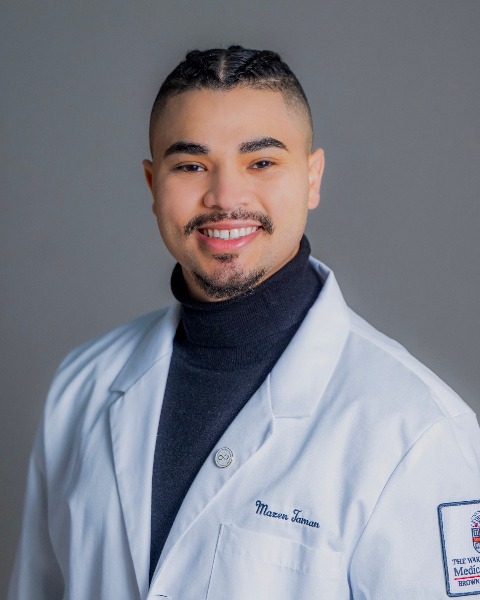Other
The Role of Recombinant Human Bone Morphogenetic Protein–2 in Atlantoaxial Arthrodesis: Institutional Predictors and Systematic Review of Outcomes
Friday, February 21, 2025

Mazen Taman, PharmD
Medical Student
The Warren Alpert Medical School of Brown University
Cranston, RI, US
Presenting Author(s)
Disclosure(s):
Mazen Taman, PharmD: No financial relationships to disclose
Introduction: Recombinant human bone morphogenetic protein-2 (rhBMP-2) is an osteoinductive material increasingly used in spinal fusion but remains controversial due to documented adverse events and uncertain efficacy. This study evaluates outcomes of rhBMP-2 in C1–2 fusion through a single-center retrospective analysis and systematic literature review.
Methods: Patients who underwent C1–2 fusion at a single institution between 2015 and 2020 were evaluated for successful arthrodesis (bony bridging at C1–2 on CT or X-ray) and complications (re-operation, pseudoarthrosis, instrumentation breakage, and wound complications). Predictors of rhBMP-2 use were identified through univariate logistic regression. A subset of eight patients who underwent isolated C1–2 fusion and received rhBMP-2 were compared with 191 cases identified from a systematic review of the literature.
Results: Our local cohort included 49 adults (57% female; mean age 61.8 [±22.8] years; mean follow-up 15.7 [±16.4] months). Of these, 49% received rhBMP-2. No significant differences between the rhBMP-2 and non–rhBMP-2 groups were observed in isolated atlantoaxial fusion (P=0.481) or complication rate (P=0.467). The overall complication rate in our cohort (29.17%) was higher than the pooled literature (5%) (P < 0.001). Radiographic evidence of fusion or early signs of fusion were identified in 89.8% of patients, with no significant difference between groups (P=0.678). Patients with degenerative indications were more likely to receive rhBMP-2 (OR 7.96, [95% CI, 1.11-22.39]; P=0.027), while those with traumatic indications were less likely (OR 0.21, [95% CI, 0.06-0.72]; P=0.016). No other variables, including age, gender, number of levels fused, concurrent decompression, and prior surgery, significantly predicted the likelihood of receiving rhBMP-2. Among eight patients with isolated C1–2 fusion, seven demonstrated successful arthrodesis. Combined with literature data, the overall fusion rate was 92.9% with a 5.15% complication rate.
Conclusion : In C1–2 fusion, the use of rhBMP-2 demonstrates comparable efficacy to non–rhBMP-2 approaches, with statistically insignificant differences in fusion and complication rates. Careful consideration of rhBMP-2 use is advised, and further research is needed to refine its role in spinal fusion.

.jpg)